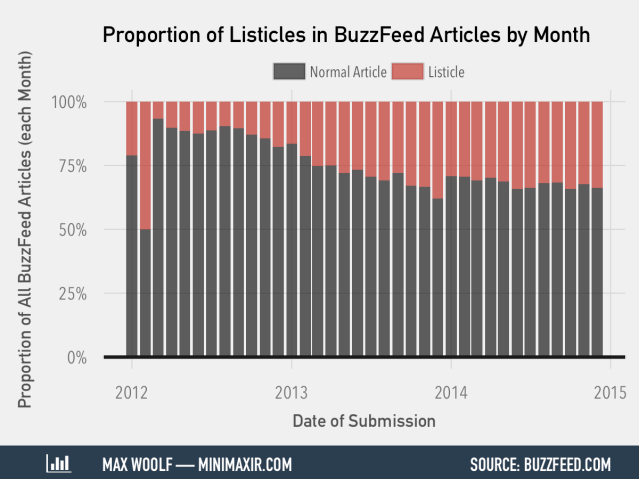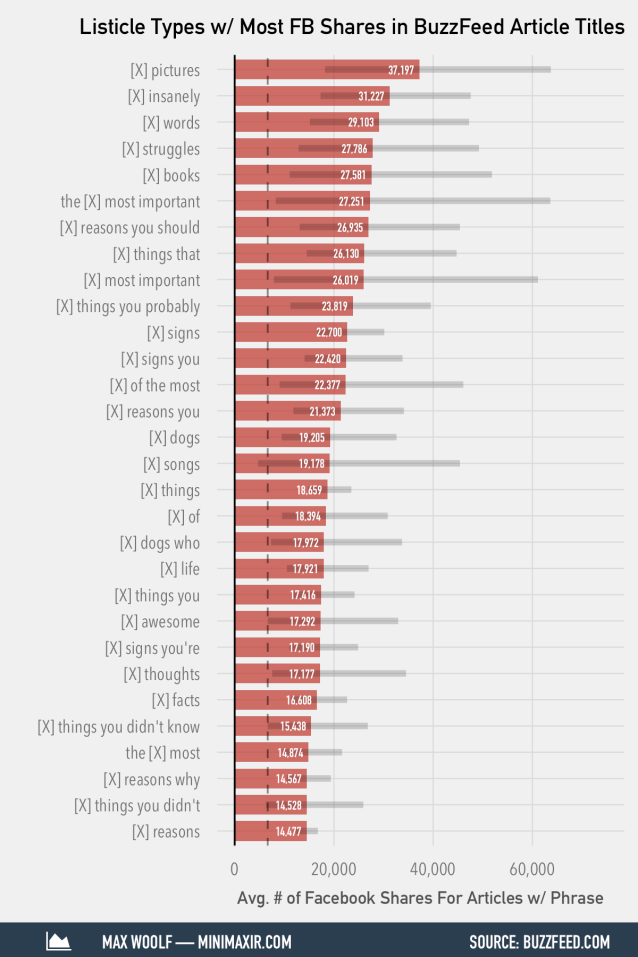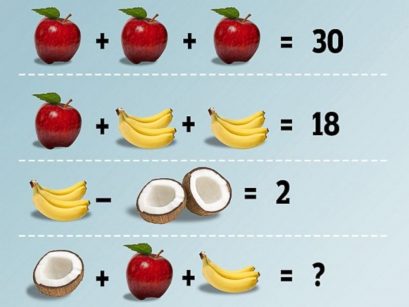In this part of our mini-series on clickbait, we look at how the success of clickbait has influenced the kinds of content we now see on social media, how we can apply these successes to our own work, and how clickbait is adapting and evolving to compete in the modern social media sphere.
If you haven’t already, you can read Part 1: Clickbait as a Case Study, here.
BuzzFeed as a clickbait microcosm
If you’d like an interesting read, BuzzFeed’s article “Why BuzzFeed Doesn’t Do Clickbait” covers some very intriguing ground. However, despite their argument we’re still going to look at BuzzFeed’s output as an example of what clickbait can achieve and more importantly how it has shaped the kind of content we see online.
Why are we doing this? Because of some fascinating research done by a man Max Woolf – who handily had a very sharp reply to BuzzFeed’s article.

Learning from BuzzFeed
In his article “Quantifying the Clickbait and Linkbait in BuzzFeed Article Titles”, Max Woolf scoured 60,378 BuzzFeed articles to pull data on the kind of content that was working for BuzzFeed – notably which of these were getting the most shares on Facebook.
Max Woolf found that of these 60,378 articles, 26% of them were lists or ‘listicles’. He also found a generally upward trend in the number of listicles BuzzFeed were producing.


Factoring this into content creation
BuzzFeed and other content producers have long been optimising social friendly content styles like the listicle.
You can quickly see how more generic titles like ‘X things’ and ‘X facts’ can be tailored to suit almost any brand offering. My advice would be not to limit yourself, you can find ways to spin most of these list roots to fit your offering. Finding different ways to frame lists, and content in general, helps keep your output fresh and engaging.
For example:
- Use an ‘X struggles’ style article can be used to highlight the pain points your offering helps to deal with – e.g. 11 Struggles All Car Owners Will Understand for a website selling car parts
- Use ‘X signs’ to encourage a repeat purchase – e.g. 9 Signs You Need to Upgrade Your Mobile Phone for a business selling the latest tech
- Be creative and find ways to tailor popular list roots to your offering – e.g. 17 Books That are Perfect Holiday Reading for a site selling cheap flights to popular holiday destinations
“Research by Outbrain showed that odd numbered lists generated 20% more clicks on average.”
Another example of how clickbait shapes content – the success of the ‘X pictures’ style of list has led to a whole sub-type of content I refer to as the image heavy blog. This kind of content is great for brands with a strong visual, photographic offering. Fashion and travel are two sectors that are well positioned to make use of this approach.
We’ll talk more about how to work out how to make this kind of content appropriate for your brand, and how you can tweak it to make it fit your tone of voice, in part 3.
The evolution of clickbait
“On a given day, when the average person visits their News Feed, there are an average of 1,500 possible stories we can show. As a result, competition for each News Feed story is increasing.” – Richard Sims, Facebook Executive
Despite all its optimisation, the listicle suffers from the same issue that faces most content on social media. We now live in a world where we can’t reach all of our social media followers with a single post, meaning this kind of content doesn’t hold the power it used to.
So like everything successful in the digital sphere, clickbait evolves. The brainteasers that were all over social media back in February are a perfect example.


A great way to build brand awareness? Potentially, if it’s right for you and your audience. More on that in part 3 of the series.
Why the focus on shares?
While we want to get our target audience to click and consume our content, the share is perhaps the Holy Grail for content marketers.
Social media expert Brian Carter says: “When we click share, we’re obviously saying ‘I like this so much, I wish I had created it myself. I want everyone I’ve connected with on Facebook to see it. I’m ok with my family, coworkers, supervisors, bosses – and anybody else I’ve friended, knowing that I like it.”
Shares are a double victory for us as content marketers. Not only do they provide the kind of endorsement Brian explains above, but they also have the potential to massively increase our social media reach.
Perhaps most importantly when talking about clickbait, as Ben Smith says in “Why BuzzFeed Doesn’t Do Clickbait”, “you can trick someone to click, but you can’t trick someone to share”.
What does all this mean for content marketing
In part 1, we looked at clickbait in terms of a case study – both of the power of the headline and in terms of what can happen when you repeatedly disappoint your audience.
In this article we’ve looked at what clickbait has done right, as well as how it’s shaped and created new forms of content – forms that we can, with a careful approach, modify and replicate to maximise our own content marketing success.
In part 3 we’ll look at how we can learn from both the successes and failures of clickbait, and what these lessons mean for us as content marketers.
The right content in the right place
Listicles, image heavy blogs and other social media friendly content styles can all serve a very specific purpose within your content marketing strategy.
That’s why it’s vital that you know both your audience and your objective, and that this content is both appropriate and tailored to both of those things.
Find out more – download The Essential Guide to Content Marketing..

